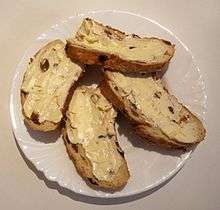Easter bread
|
Easter Bread of Germany | |
| Type | Bread |
|---|---|
| Other information | Prepared for Easter |
|
| |
In many European countries, there are various traditions surrounding the use of bread during the Easter holidays. Traditionally the practice of eating Easter bread or sweetened "communion" bread traces its origin back to Byzantium and the Orthodox Christian church. The recipe for sweetened or "honey-leavened" bread may date back as far as the Homeric Greek period based on anecdotal evidence from classical texts that mention this type of special food. It is also widely known that sweetened bread desserts similar to panettone were a Roman favorite.
Bulgaria, Russia, Belarus, Ukraine, Romania
A cozonac is traditional Easter bread in Bulgaria, kulich is a traditional Russian Easter bread. Kolach is a traditional Czech bread made at Christmas in the shape of a ring. Usually, three rings are stack on top of each other to represent the Holy Trinity. Ukrainian Easter bread is called Paska, which is a rich, white bread decorated on the top with symbols, including crosses, flowers, braids, wheat, or other designs representing aspects of Orthodox and Eastern Catholic faith. Babka is also a Ukrainian, Polish and Belarusian bread also made at Easter. Rather than being broad and round, like Paska, babka typically is tall and cylindrical, often baked in bundt-type pan. It frequently contains raisins, may be iced on top, and is much sweeter than Paska. Babka usually is only made, like Paska, to celebrate Easter Sunday and the rising of Christ.
Romania and Moldova also have a traditional Easter bread called Pasca (The term Pasca is "Easter" in the Eastern Orthodox faith, similar to Pâques in French. It is derived from the Hebrew pesah.). The Romanian Pasca bread is made with cheese (and may also include fruits, nuts, or chocolate for decoration). It is usually be found alongside another traditional sweet bread which Romanians make for Easter and Christmas called cozonac.[1]
Germany

During the weeks before Easter, special Easter bread is sold (in German: Osterbrot, ![]() listen ). This is made with yeast dough, raisins, and almond splinters. Usually, it is cut in slices and spread with butter. People enjoy it either for breakfast or for tea time (in German: Kaffee und Kuchen, literally ″coffee and cake″).
listen ). This is made with yeast dough, raisins, and almond splinters. Usually, it is cut in slices and spread with butter. People enjoy it either for breakfast or for tea time (in German: Kaffee und Kuchen, literally ″coffee and cake″).
Netherlands
See also: Kerststol
The Dutch Easter bread is the so-called 'stol', a fruit bread with raisins and usually filled with almond paste. It is the same type of bread also eaten as a Christmas bread.
Sardinia
In Sardinia, Italy, bread is a part of a wide social context. It is the most important food in Sardinia, as well as all over Italy and the Mediterranean. "Bread is a nexus of economic, political, aesthetic, social, symbolic, and health concerns".[2] Bread is symbolic for life. A peasant proverb mentions, "Chie hat pane mai non morit — one who has bread never dies".[3] The Easter holiday is one where bread brings itself into the symbolic realm. Bread is significant for religious purposes. Luisa Fois described bread in her life after she was married and for the Easter holiday. The bread was made into a cross to represent the crucifixion of Jesus Christ. Since they were married, they needed to eat it together. They would share their lives now, and they must share their "cross" together (their life's burden) as well. "Bread was a product of their union, and its shared consumption reaffirmed their interdependence".[4] From this we gather that bread also displays a message, rather than being an item purely for consumption and nutritional purposes. Two kinds of Easter bread are described in Counihans article. One contained two points, and an egg covered with a cross. "The egg and the points that recall birds in flight speak of fertility, sexuality, and procreation — basic themes in Easter and its pagan precursors".[5] The second bread was designed to have no overall shape, but was rather baked to encircle an egg, with the initials BP put on it. The initials BP stand for buona Pasqua or "happy Easter". "Letters rather than forms express meaning. Letters are symbolic of civilization and ... meaning".[6]
See also
References
- ↑ "Pasca–Romanian Easter Bread with Cheese and fruits".
- ↑ Counihan, Carole. The Anthropology of Food and Body: Gender, Meaning, and Power. New York: Routledge, 1999 p.29
- ↑ Counihan, Carole. The Anthropology of Food and Body: Gender, Meaning, and Power. New York: Routledge, 1999 p.29
- ↑ Counihan, Carole. The Anthropology of Food and Body: Gender, Meaning, and Power. New York: Routledge, 1999 p.30
- ↑ Counihan, Carole. The Anthropology of Food and Body: Gender, Meaning, and Power. New York: Routledge, 1999 p.41
- ↑ Counihan, Carole. The Anthropology of Food and Body: Gender, Meaning, and Power. New York: Routledge, 1999 p.41
Sources
- Counihan, Carole. The Anthropology of Food and Body: Gender, Meaning, and Power. New York: Routledge, 1999.
External links
| Wikimedia Commons has media related to Easter breads. |
- Breads for Christ: European Easter Breads Shaped for the Season
- Easter bread recipe
- A 2009 article about the origin of chocolate babka. Ari Weinzweig, "Babka, Trans-Atlantic Jewish Delight" The Atlantic. April 30, 2009
